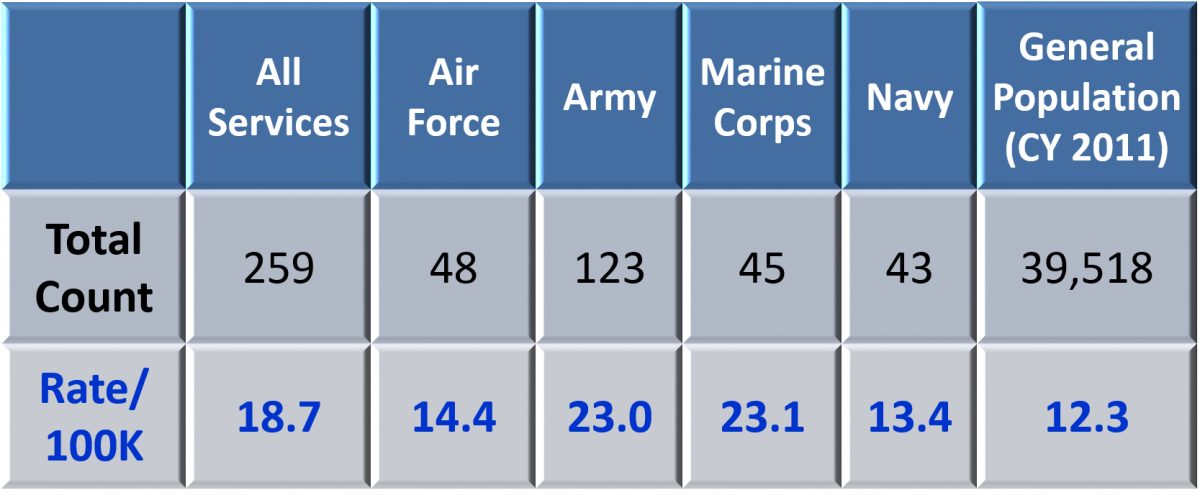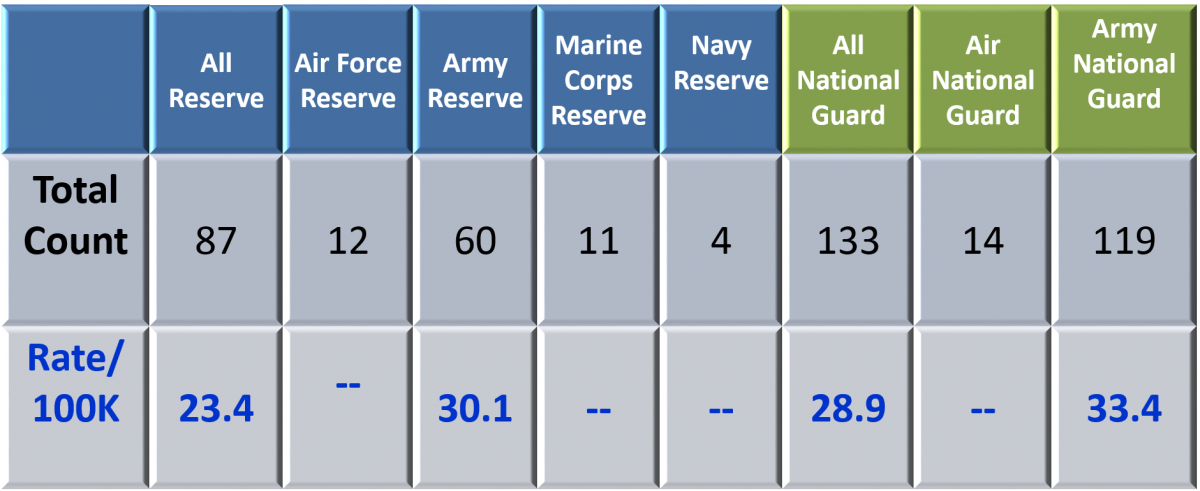Staff Perspective: A Look at the 2013 Department of Defense Suicide Event Report
I vividly remember when the Department of Defense (DoD) transitioned to using the DoD Suicide Event Report (DoDSER) system. I was a young Air Force psychologist stationed in Germany at the time and I remember thinking, “Oh no, one more new system to learn”. However, I now know how valuable the DoDSER program is in helping standardize suicide surveillance across the Services. The DoDSER program is a collaborative effort of Telehealth and Technology (T2) and the Services’ (Air Force, Army, Navy, and Marine Corps) suicide prevention program offices. The transition to using the DoDSER across the Services occurred in 2008 and since then the DoD has been collecting suicide data via this system. Prior to the transition in 2008, the Service branches used different surveillance systems, which made it difficult to compare data.
Every year the DoD releases the most up-to-date DoDSER report, which summarizes fatal and non-fatal suicide events for U.S. Service members. The DoDSER report provides a wealth of information about suicide events and rates, demographic information, as well as psychosocial stressors, behavioral health history and deployment history for each suicide event. It also helps inform Service level suicide prevention efforts. The most current DoDSER report (for calendar year 2013) was released on January 16, 2015.
The most recent DoDSER report shows that in 2013 the Active Component suicide totals and rates declined while the Selected Reserve had a slight increase compared to calendar year 2012. The Selected Reserve includes both the Reserve and National Guard components and an increase was seen in both in 2013.
In calendar year 2013, there were 259 suicides among Active Component Service members, which is a rate of 18.7 per 100,000. The rates (per 100,000) for the Active Components of the four services were as follows: 14.4 Air Force, 23 Army, 23.1 Marine Corps, and 13.4 Navy. It is not uncommon to see the Army and Marine Corps with the highest rates. The Army had the highest rates in 2011 and 2012, but the Marine Corps rate was higher in 2013 (although closely followed by the Army). (See Table 1 below.)
Table 1. Active Component Suicides and Rates (2013)
In calendar year 2013, there were also 220 suicides among the Selected Reserve components to include 87 suicides for the Reserve and 133 for the National Guard, which is a rate of 23.4 and 28.9 respectively. Per the 2013 DoDSER report, the number of suicides in the Selected Reserve for each Service was too small to calculate stable unadjusted rates with the exception of the Army Reserve (30.1) and Army National Guard (28.9). (See Table 2 below for Service specific total counts. )
Table 2. Selected Reserve Suicides and Rates (2013)
There were 245 suicide DoDSERs and 1080 suicide attempt DoDSERs completed and submitted by the Services. Of the completed suicide DoDSERs, 187 had been confirmed by the Armed Forces Medical Examiner System as of January 31, 2014. So what does the DoDSER tell us about Service members who died by suicide or attempted suicide in 2013?
The most common demographic characteristics for Service members who died by suicide or attempted suicide in calendar year 2013 were: male, white/Caucasian, non-Hispanic, under 30 years of age, junior enlisted (E1-E4), and educated through high school.
The most common behavioral health diagnoses for suicide DoDSERs were mood disorders (59.8%) and adjustment disorders (56.7%). The most common behavioral health diagnoses for suicide attempt DoDSERs were mood disorders (60%) and anxiety disorders (50.2%). As we have seen in prior years, the most common psychosocial factor for both suicides and suicide attempt DoDSERs was a failed relationship, and primarily a relationship that was intimate in nature (44.9% for suicides and 40.9% for suicide attempts).
For suicide DoDSERs, the most prevalent method was gunshot (60.8%) of which most (88.6%) were by non-military issued firearms, followed by hanging/asphyxiation (29.4%). For suicide attempt DoDSERs, the most prevalent method was use of drugs and/or alcohol overdose (56.9%).
Looking at deployment related factors, 66.5% of suicide DoDSERs and 42.7% of suicide attempt DoDSERs had a history of deployment (with the majority of both categories having only one deployment). In addition, 14.7% of suicide DoDSERs and 19.4% of suicide attempt DoDSERs had direct combat histories. There were 13 suicide DoDSERs completed for suicides that occurred in theater (5.3%) and 37 suicide attempt DoDSERs completed for suicide attempts that occurred in theater (3.4%).
As I mentioned above, I think that having a unified suicide surveillance system is extremely important. Like any data collection system, there are limitations (e.g., being retrospective in nature, information per event can vary). However, overall it is a helpful tool, and is already helping us better understand some of the risk factors for suicidal behaviors among Service members.
I have provided only a brief snapshot of what is included in the 2013 DoDSER report. For more information I encourage you to look at the entire report, which can be accessed at: http://www.suicideoutreach.org/Docs/Reports/2013_DoDSER_Annual_Report.pdf
Dr. Lisa French is Assistant Director of Military Training Programs at the Center for Deployment Psychology.
Reference:
Smolenski, D.J., Reger, M.A., Bush, N.E., Skopp, N.A., Zhang, Y., & Campise, R.L. (2014). Department of Defense Suicide Event Report Calendar Year 2013 Annual Report. National Center for Telehealth & Technology and Defense Centers of Excellence for Psychological Health & Traumatic Brain Injury.
I vividly remember when the Department of Defense (DoD) transitioned to using the DoD Suicide Event Report (DoDSER) system. I was a young Air Force psychologist stationed in Germany at the time and I remember thinking, “Oh no, one more new system to learn”. However, I now know how valuable the DoDSER program is in helping standardize suicide surveillance across the Services. The DoDSER program is a collaborative effort of Telehealth and Technology (T2) and the Services’ (Air Force, Army, Navy, and Marine Corps) suicide prevention program offices. The transition to using the DoDSER across the Services occurred in 2008 and since then the DoD has been collecting suicide data via this system. Prior to the transition in 2008, the Service branches used different surveillance systems, which made it difficult to compare data.
Every year the DoD releases the most up-to-date DoDSER report, which summarizes fatal and non-fatal suicide events for U.S. Service members. The DoDSER report provides a wealth of information about suicide events and rates, demographic information, as well as psychosocial stressors, behavioral health history and deployment history for each suicide event. It also helps inform Service level suicide prevention efforts. The most current DoDSER report (for calendar year 2013) was released on January 16, 2015.
The most recent DoDSER report shows that in 2013 the Active Component suicide totals and rates declined while the Selected Reserve had a slight increase compared to calendar year 2012. The Selected Reserve includes both the Reserve and National Guard components and an increase was seen in both in 2013.
In calendar year 2013, there were 259 suicides among Active Component Service members, which is a rate of 18.7 per 100,000. The rates (per 100,000) for the Active Components of the four services were as follows: 14.4 Air Force, 23 Army, 23.1 Marine Corps, and 13.4 Navy. It is not uncommon to see the Army and Marine Corps with the highest rates. The Army had the highest rates in 2011 and 2012, but the Marine Corps rate was higher in 2013 (although closely followed by the Army). (See Table 1 below.)
Table 1. Active Component Suicides and Rates (2013)
In calendar year 2013, there were also 220 suicides among the Selected Reserve components to include 87 suicides for the Reserve and 133 for the National Guard, which is a rate of 23.4 and 28.9 respectively. Per the 2013 DoDSER report, the number of suicides in the Selected Reserve for each Service was too small to calculate stable unadjusted rates with the exception of the Army Reserve (30.1) and Army National Guard (28.9). (See Table 2 below for Service specific total counts. )
Table 2. Selected Reserve Suicides and Rates (2013)
There were 245 suicide DoDSERs and 1080 suicide attempt DoDSERs completed and submitted by the Services. Of the completed suicide DoDSERs, 187 had been confirmed by the Armed Forces Medical Examiner System as of January 31, 2014. So what does the DoDSER tell us about Service members who died by suicide or attempted suicide in 2013?
The most common demographic characteristics for Service members who died by suicide or attempted suicide in calendar year 2013 were: male, white/Caucasian, non-Hispanic, under 30 years of age, junior enlisted (E1-E4), and educated through high school.
The most common behavioral health diagnoses for suicide DoDSERs were mood disorders (59.8%) and adjustment disorders (56.7%). The most common behavioral health diagnoses for suicide attempt DoDSERs were mood disorders (60%) and anxiety disorders (50.2%). As we have seen in prior years, the most common psychosocial factor for both suicides and suicide attempt DoDSERs was a failed relationship, and primarily a relationship that was intimate in nature (44.9% for suicides and 40.9% for suicide attempts).
For suicide DoDSERs, the most prevalent method was gunshot (60.8%) of which most (88.6%) were by non-military issued firearms, followed by hanging/asphyxiation (29.4%). For suicide attempt DoDSERs, the most prevalent method was use of drugs and/or alcohol overdose (56.9%).
Looking at deployment related factors, 66.5% of suicide DoDSERs and 42.7% of suicide attempt DoDSERs had a history of deployment (with the majority of both categories having only one deployment). In addition, 14.7% of suicide DoDSERs and 19.4% of suicide attempt DoDSERs had direct combat histories. There were 13 suicide DoDSERs completed for suicides that occurred in theater (5.3%) and 37 suicide attempt DoDSERs completed for suicide attempts that occurred in theater (3.4%).
As I mentioned above, I think that having a unified suicide surveillance system is extremely important. Like any data collection system, there are limitations (e.g., being retrospective in nature, information per event can vary). However, overall it is a helpful tool, and is already helping us better understand some of the risk factors for suicidal behaviors among Service members.
I have provided only a brief snapshot of what is included in the 2013 DoDSER report. For more information I encourage you to look at the entire report, which can be accessed at: http://www.suicideoutreach.org/Docs/Reports/2013_DoDSER_Annual_Report.pdf
Dr. Lisa French is Assistant Director of Military Training Programs at the Center for Deployment Psychology.
Reference:
Smolenski, D.J., Reger, M.A., Bush, N.E., Skopp, N.A., Zhang, Y., & Campise, R.L. (2014). Department of Defense Suicide Event Report Calendar Year 2013 Annual Report. National Center for Telehealth & Technology and Defense Centers of Excellence for Psychological Health & Traumatic Brain Injury.

